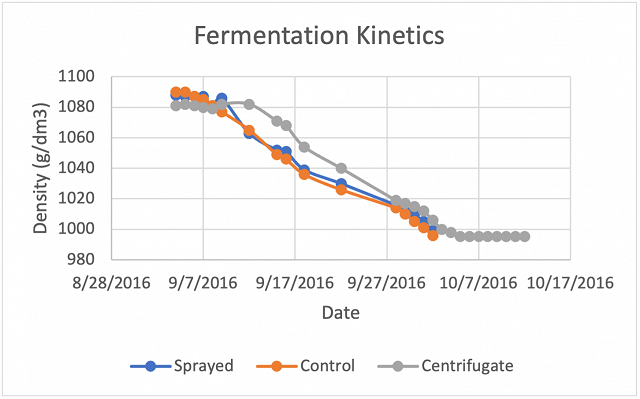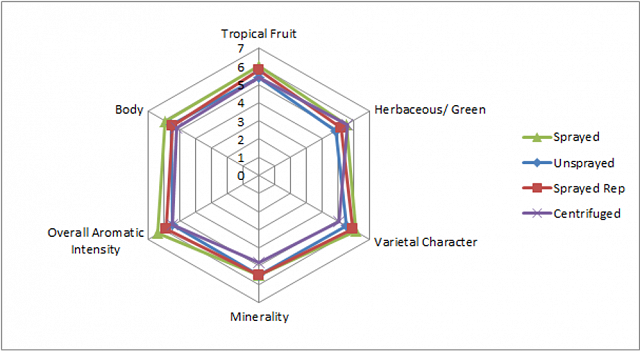The Effect of Timed Nitrogen and Sulfur Sprays on Sauvignon Blanc (2016)
Jonathan Wheeler
Trump Winery
Summary
This study examines the impact of timed Nitrogen and Sulfur sprays on the sensory and chemical attributes of Sauvignon Blanc. A mix of Nitrogen and Sulfur sprayed at 20% veraison and at 50% veraison were applied to 2 out of four segments of a vineyard block. The other segments were unsprayed. The grapes were harvested and processed identically. After racking off of gross lees, the lees were harvested, combined, and centrifuged to create a centrifugate juice (a mix of the lees from the control and sprayed grapes). All fermentation practices were identical between lots, except that the centrifuged juice had to receive an extra acidulation. No major chemical differences were found between the control and treated juice and wines, except that pH was slightly higher. The sprayed wine had a slightly higher level of 3-MH. However, the wine made from the combined lees centrifugate had the higest level of 3-MH and lower levels of 3-mercaptohexylacetate. Additionally, this wine had a longer lag phase during fermentation compared to the other two. Judges were generally able to distinguish between the unsprayed and sprayed treatments, and there was a tendency for the sprayed treatment to be preferred and the centrifuged treatment to be least preferred. The sprayed wine had slight tendencies to have higher Overall Aromatic Intensity, Herbaceous/Green character, and Varietal Character. There were slight trends for the centrifuged wine to have lower Tropical Fruit and Varietal Character than the other treatments, and higher Herbaceous/Green character. These tendencies were all very weak, however.
Introduction
High nitrogen in grape must is often correlated to higher Sauvignon Blanc varietal thiols in wine (Choné et al. 2006). Recent studies have suggested that combinations of foliar nitrogen sprays with sulfur foliar sprays at veraison can influence the varietal thiol content of Sauvignon Blanc wines (Charrier and Dufourcq 2007; Lacroux et al. 2008; Dufourcq et al. 2009). This study examines the impact of this viticultural technique on Sauvignon Blanc wines in Virginia.
Results and Discussion
No major chemical differences were found between the control and treated juice and wines, except that pH was slightly higher. The sprayed wine had a slightly higher level of 3-MH. The wine made from the combined lees centrifugate had the highest level of 3-MH and lower levels of 3-mercaptohexylacetate. Additionally, this wine had a longer lag phase during fermentation compared to the other two.






For the triangle test on March 15, of 32 people who answered, 19 people chose the correct wine (59%), showing a statistically significant difference between wines (p<0.01). These wines were voted to have an average degree difference of 4.5 (out of 10), suggesting that the wines were moderately different. In general, people who answered correctly preferred the sprayed treatment, and preferred the centrifuged treatment the least.

When the centrifuged wine was included, no major trends could be seen. The sprayed wine showed slight tendencies to have higher Overall Aromatic Intensity, Varietal Character, and Body. The centrifuged wine was lower in Minerality, Overall Aromatic Intensity, Tropical Fruit, and Varietal Character. The Unsprayed wine tended to be between these treatments, but these trends were overall small.

When the centrifuged wine is excluded, the trends became less apparent. Overall Aromatic Intensity still tended to be slightly higher in sprayed wines.

For the triangle test on May 17, of 7 people who answered, 5 people chose the correct wine (71%), showing a statistically significant difference between wines (p<0.05). These wines were voted to have an average degree difference of 3.4 (out of 10), suggesting that the wines were not very different. In general, people who answered correctly preferred showed no major preferences, but tended to prefer the centrifuged wine the least. Descriptive analysis did not show any strong trends with the descriptors used in this study. There were slight trends for the centrifuged wine to have lower Tropical Fruit and Varietal Character than the other treatments, and higher Herbaceous/Green character.


Overall, judges were generally able to distinguish between the unsprayed and sprayed treatments, and there was a tendency for the sprayed treatment to be preferred and the centrifuged treatment to be least preferred. The sprayed wine had slight tendencies to have higher Overall Aromatic Intensity, Herbaceous/Green character, and Varietal Character. There were slight trends for the centrifuged wine to have lower Tropical Fruit and Varietal Character than the other treatments, and higher Herbaceous/Green character. These tendencies were all very weak, however. This study should be repeated over several vintages, and in combination with different Sauvignon Blanc winemaking styles. Another approach which would be interesting would be to attempt this study with higher juice turbidity, as well as with skin contact.
Methods
Nitrogen (Coron 28-0-0 slow release N) at 1 gallon/acre as well as Sulfur at 5 pounds/acre were sprayed in two applications: once at 20% veraison and once at 50% veraison. One 4-acre block was sprayed with this mixture in an on-off treatment, splitting the 4 acre block into 1 acre segments and making each segment a treatment or control segment. The block was thus split into alternating treatment/control areas.
There were 3 treatments: 1 control, 1 experimental, and 1 wine made from combined lees centrifugate of lees from control and experimental juice and wine. Grapes were harvested, crushed, and cold soaked on 8/29, and on 8/30 the grapes were drained and pressed. During the cold soak each lot received 50ppm sulfur dioxide, 3g/100kg Lafazyme extract, and 150g/hL tartaric acid. During pressing each treatment received 1g/hL Lafazyme CL. The juice was cold settled and then racked twice, once on 9/1 and again on 9/2. At the second racking, 150g/hL tartaric acid was added. On 9/3 the heavy lees from both the control and the treatment lot were centrifuged, and the centrifugate (353 gallons) was collected, acidulated with 150g/hL tartaric acid, and inoculated in a separate tank. The control and treatment were also inoculated, with 20g/hL Alchemy 2 yeast rehydrated with 15g/hL GoFerm. On 9/8, the fermenting juice was chaptalized with approximately 60-70 pounds of sugar. On 9/13, 25g/hL Fermaid K was added to the fermentations. Fermentation had completed by 10/13, and the settled wine was racked on 10/13 and again on 10/14. On 10/13 the wine was stabilized with 38ppm sulfur dioxide. The control and treatment wine was racked and returned on 12/5 with an addition of 18ppm sulfur dioxide, and the centrifugate wine was racked on 12/12 with 15ppm sulfur dioxide added.
This study was tasted on March 15 and May 17. For the triangle test and preference analysis, anybody who did not answer the form were removed from consideration for both triangle, degree of difference, and preference. Additionally, anybody who answered the triangle test incorrectly were removed from consideration for degree of difference and preference. Additionally, any data points for preference which did not make sense (such as a person ranking a wine and its replicate at most and least preferred, when they correctly guessed the odd wine) were removed. The centrifuged sample was ignored for triangle testing (but not for preference or descriptive analysis), and only the sprayed vs unsprayed samples were compared.
In order to balance the data set to perform statistical analysis for descriptive analysis on the March 15 tasting, any judge who had not fully completed the descriptive analysis ratings were removed. Due to confusion by the judges, not all judges rated the centrifuged sample. Thus, the descriptive analysis data was analyzed twice, once with the centrifuged wine and once without it. In order to then make the amount of judges between groups equivalent for the analysis which included the centrifuged wine, one judge from group 1 and group 3 were transferred to group 2. This resulted in a final data set of 3 groups, each with 5 judges (considered as replications within groups, and groups were considered as assessors). The data was also analyzed excluding the centrifuged wine, in order to increase the pool of judges for statistical analysis. With this data set, one judge was moved from group 1 to group 2, and then one judge was removed from both group 1 and group 3. This resulted in 3 groups each with 7 judges.
Data was analyzed using Panel Check V1.4.2. Because this is not a truly statistical set-up, any results which are found to be statistically significant (p<0.05) will be denoted as a “strong trend” or a “strong tendency,” as opposed to general trends or tendencies. The statistical significance here will ignore any other significant effects or interactions which may confound the results (such as a statistically significant interaction of Judge x Wine confounding a significant result from Wine alone). The descriptors used in this study were Tropical Fruit, Herbaceous/Green, Varietal Character, Minerality, Overall Aromatic Intensity, and Body.
The same procedures for data analysis were used on the May 17 tasting. For the descriptive analysis in this tasting, each group had two judges, for a total of 6 judges.
References
Charrier, F. and Dufourcq, T. 2007. Influence de l’apport d’azote foliaire sur le potential aromatique des vins blancs. Proceedings 8th Symposium d’oenologie de Bordeaux (France).
Choné, X., Lavigne-Cruege, V., Tominaga, T, Van Leeuwen, C., Castagnede, C., Saucier, C., and Dubourdieu, D. 2006. Effect of vine nitrogen status on grape aromatic potential: flavor precursors (S-cystein conjugates), glutathione and phenolic content in Vitis vinifera L. cv. Sauvignon blanc grape juice. J. Int. Sci. Vigne Vin. 40:1-6.
Dufourcq, T., Charrier, F., Poupalt, P., Schneider, R., Gontier, L., and Serrano, E. 2009. Foliar spraying of nitrogen and sulfur at veraison: a viticultural technique to improve aromatic composition of white and rosés wines. 16th International GiESCO Symposium. Davis (USA).
Lacroux, F., Trégoat, O., Van Leeuwen, C., Pons, A., Tominaga, T., Lavigne-Cruège, V., and Dubourdieu, D. 2008. Effect of foliar nitrogen and Sulphur application on aromatic expression of Vitis Vinifera L. cv. Sauvignon blanc. J. Int. Scie. Vigne Vin. 42(3):125-132.
